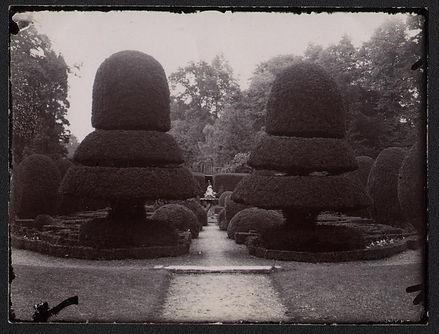History
An important garden with timeless appeal
Bridge End Garden is a designated heritage asset. It is considered important because it is a rare example of a late Regency garden and an early Victorian historical revival garden. Even though no ‘big house’ was attached to the Garden, it is also considered a rare example of a Victorian villa garden. The Garden is an important part of the Quaker history of the town. It is within a Conservation Area and is registered Grade II* on Historic England’s Register of Parks and Gardens of Special Historic Interest. The Pavilion, Summerhouse, some gates and several brick walls that enclose different areas of the Garden are listed Grade II by Historic England.
Who created the Garden?
At the end of the eighteenth century Atkinson Gibson, a prominent Quaker businessman in Saffron Walden, began making a garden on land that he owned behind the family brewing and malting business in Bridge Street. Little is known about this original garden, but it was modest in scale. What is certain is that in the late 1830s, Francis Gibson (1805-1858), Atkinson’s youngest son, enlarged and developed the Garden. It is largely due to Francis’s knowledge, enthusiasm and attention to detail that the garden we enjoy today was created.


The Gibson family
As the eighteenth turned into the nineteenth century, the only bank in the town was owned by another prominent Saffron Walden family, the Searles. When they decided to diversify into brewing – in direct competition with the Gibson family – the Gibsons responded by founding their own bank, the Saffron Walden and North Essex Bank, which opened in 1824. The following year a stock market crash resulted in the closure of Searles’ bank. Thus, by a twist of fate, the Gibson bank remained the only one in the town. It flourished, and the wealth of the Gibson family increased as they moved out of brewing to focus on banking.
In 1829 Francis married Elizabeth Pease from Darlington, daughter of the Quaker businessman and railway entrepreneur Edward Pease. For all their married life they lived at The Close, situated at the junction of the High Street and Castle Street, together with their children Elizabeth and Francis (known as Bessie and Frank to avoid confusion with their parents!). The garden at The Close was not large enough for any grand landscaping plans, so around 1836 Francis turned his attention to enlarging and developing the nearby garden, tucked behind Bridge Street, that had been begun by his father.
It is possible that Francis consulted with William Chater, the Saffron Walden nurseryman and landscape gardener, who became renowned for the development of the double hollyhock. To what extent any collaboration took place is unknown, but they would have undoubtedly known each other well. Chater and Francis were born within three years of each other, and both were founder members of the Saffron Walden Horticultural Society. Chater’s obituary in the Gardeners’ Chronicle, 1885, credits him with working both at Hutton Hall in Guisborough for Sir J.W. Pease (Francis’s brother-in-law) and for laying out the churchyard at St Cuthbert’s Church in Darlington, the hometown of the Pease family. These must be more than random connections.
We know from the diaries kept by Francis, Bessie and Frank that the family travelled widely, both in the United Kingdom and abroad. Wherever they went they took every opportunity to visit public and private gardens, and Francis read about those such as Levens Hall and Hampton Court, so he was aware of the current trends in garden design and topiary. Francis was an accomplished artist and had a keen eye for visual impact. In 1835 he writes of being "...very fond of system and method, particularly in "aesthetics" and of having "good ideas of dimensions, parallel lines and uprights, things out of either easily detected".

Construction of the garden is thought to have begun in 1837. By January of the following year Francis was making a shopping list of items to purchase from London including vases, seat, scrolls, balusters, an iron gateway, two pineapples for piers and stone steps. Serendipity played its part, for Francis had money and land, a flair for design, a meticulous nature and a determination to realise his vision. It is thought that the Garden was complete by the summer of 1840. Entries in the Gibson diaries tell of games of battledore (played with a shuttlecock and racquets) taking place in the garden and of visits to pick flowers to make posies.

A delightful line drawing of children at play in the walled garden by Bardfield artist Edward Bawden from 1932.
(Fry Art Gallery© the Estate of Edward Bawden)


From Gibson to Fry
Francis died in 1858. Later that year his daughter Bessie married Lewis Fry, a Bristol lawyer and a member of the Quaker family well known for their chocolate business. Lewis was later elected MP for Bristol and had a distinguished career in public service. In 1865, four years after Bessie’s unmarried brother Frank died, Elizabeth left Saffron Walden to join her daughter in Bristol for a short time before she passed away at the end of January 1866. Bessie sadly died four years later, aged 40, leaving five young children. The Garden had thus become a Fry garden rather than a Gibson garden, and has remained so ever since.
The Garden has been an invaluable resource to the town over the years, being the location for all manner of special occasions, including dramatic productions, pageants, weddings, exhibitions and more.



A line drawing by Edward Bawden of The Gardener's Cottage over Castle Street Path at Bridge End Garden from 1950.
(Fry Art Gallery© the Estate of Edward Bawden)
The photos on this page are reproduced by kind permission of Mark Fry, Saffron Walden Museum, Uttlesford District Council and the Frenchay Village Museum.